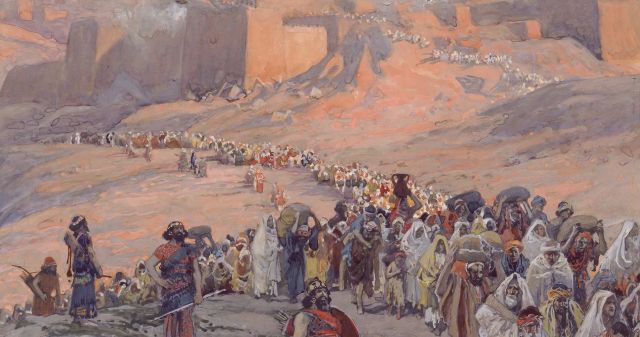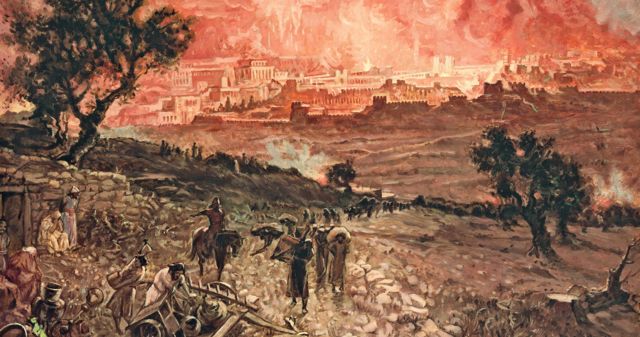Here is a collection of reliable resources to supplement your study of 2 Kings 17-25. FAIR Resources link to relevant questions which have been answered on the FAIR website. Other Resources link to resources outside of FAIR that are trustworthy and helpful. Under Church Resources you’ll find links to the different Come, Follow Me manuals, as well as other helpful links as applicable. Also on the page are the lesson summary and a guest scholar’s article.

What New Archaeological Discoveries in Jerusalem Relate to Hezekiah?
Would Israelites not have constructed a temple outside of Jerusalem?
Lesson 13: The Allegory of the Olive Trees
Find Answers on FAIRLATTERDAYSAINTS.ORG
INTERPRETER
Come, Follow Me Study and Teaching Helps — Lesson 29: 2 Kings 17–25, Jonn Claybaugh
Audio Roundtable: Come, Follow Me Old Testament Lesson 29 (2 Kings 17–25)
BOM CENTRAL
Come Follow Me Insights – 2 Kings 17-25: Lost and Found, Book of Mormon Central
The Lost Ten Northern Tribes (Week 29, Part 1/6) 2 Kings 17-25 | July 11- July 17, Book of Mormon Central
Hezekiah Stops the Worship of Other Gods (Week 29, Part 2/6) 2 Kings 17-25 | July 11- July 17, Book of Mormon Central
The Lesser Known Story of Hezekiah’s Passover (Week 29, Part 3/6) 2 Kings 17-25 | July 11- July 17, Book of Mormon Central
King Hezekiah and King Manasseh (Week 29, Part 4/6) 2 Kings 17-25 | July 11- July 17, Book of Mormon Central
King Josiah and His Good Works (Week 29, Part 5/6) 2 Kings 17-25 | July 11- July 17, Book of Mormon Central
The Last Five Kings of Judah (2 Kings 23–25) | Part 6/6
BYU Studies
“Hezekiah’s Tunnel Vision,” Charles A. Muldowney, Ensign September 2002
“Five Empires of the Ancient Near East: A Historical Backdrop of 1 Kings to Matthew,” John A. Tvedtnes, Ensign, April 1982
“Is the Bible Reliable? A Case Study: Were King Josiah’s Reforms a Restoration from Apostasy or a Suppression of Plain and Precious Truths? (And What about Margaret Barker?” Eric A. Eliason, BYU Studies Quarterly 60, no. 3
“Joseph Smith and Preexilic Israelite Religion,” Margaret Barker, BYU Studies 44, no. 4
“Amos through Malachi: Major Teachings of the Twelve Prophets,” Blair G. Van Dyke and D. Kelly Ogden, Religious Educator 4, no. 3
“The Restoration as Covenant Renewal,” David Rolph Seely, Sperry Symposium Classics: The Old Testament, (2005): 311–336
OTHER
The Scriptures are Real – Kerry Muhlestein
The Storyline of Kings: The Fall of Israel and then Judah (week of July 11, first to watch)
Gaye Strathearn on Lessons from Lachish in the fall of Judah (week of July 11, 2nd to listen to)
Flashing Mirrors at Tel Lachish and Tel Azekah (week of July 11, 3rd to watch)
Lessons from the Fall of Israel (week of July 11, 4th to watch)
Bible Project

Lesson Summary
Despite the prophet Elisha’s impressive ministry, the spirituality of the Northern Kingdom of Israel kept declining. Wicked kings promoted idolatry, and war and apostasy abounded. Finally the Assyrian Empire conquered and scattered the ten tribes of Israel.
Meanwhile, the Southern Kingdom of Judah wasn’t doing much better; idolatry was also widespread there. But amid all this spiritual decay, the scriptural accounts mention two righteous kings who, for a time, turned their people back to the Lord. One was Hezekiah. During his reign, the Assyrians, fresh from their victory in the north, conquered much of the south. But Hezekiah and his people showed faith in the Lord, who delivered Jerusalem in a miraculous way. Later, after another period of apostasy, Josiah began to reign. Inspired in part by a rediscovery of the book of the law, Josiah brought reforms that revived the religious life of many of his people.
What do we learn from these two bright spots in the otherwise dark years of Judah’s history? Among other things, you might ponder the power of faith and of the word of God in your life. Like Israel and Judah, we all make both good and bad choices. And when we sense that reforms are needed in our lives, perhaps the examples of Hezekiah and Josiah can inspire us to “trust in the Lord our God” (2 Kings 18:22).
Guest Post Coming Soon


by Shauna Horne
[Courtesy of Wilford Woodruff Papers]
Wilford Woodruff said, “Brethren and sisters, let us read the revelations of God for ourselves, and when we read them, let us believe them, and try to live in such a way that we may be ready for whatever dispensation the Lord may have in store for us.”
Has there ever been a scripture that changed you? This week while studying 2 Kings 23, the story of King Josiah stuck out to me. He read the scriptures that were found in the temple, and they had a huge impact on him. They changed him.
I, as well, have been changed by scripture. I had one especially personal and life-changing experience as I was going through my divorce after 22 years of marriage. I had anger towards my soon-to-be ex-husband—years of built-up anger coming out in a hurry. At times it felt like I was going to explode. I didn’t like who I was or who I was becoming. I remember on a particularly difficult day kneeling down on the floor at work and crying out to the Lord, telling Him that I could not continue like this. The anger was too much. I told Him I needed to heal and move on. I poured out my heart to Him, crying for His help. I desperately needed Him. He whispered back to me, ‘Recite the Living Christ.’
Years before, my daughter and I had memorized ‘The Living Christ: The Testimony of the Apostles’ together. It was an awesome experience. I did not know that six years later, that sacred text would be what helped me heal from a broken heart. Immediately, I pulled the document up on my phone and began to recite it. Every time I had an angry or ugly feeling towards my husband, I would start at the beginning.
This document, this modern-day scripture, healed my heart. There is no way to read about our Lord and Savior without feeling His spirit. Each time I recited it, my heart became a little softer. The pain was a little less intense. It took time to heal, but in that very moment I had relief from agonizing pain. I can testify that the Lord literally healed my broken heart. He saved my soul from agony. Scripture, both modern and ancient, can change lives. Studying the pages of God’s words has changed my life forever.
More Come, Follow Me resources here.
 Shauna graduated from Brigham Young University-Idaho in April 2022 with a Bachelor’s Degree in Marriage and Family. She has spent most of her life raising her four children and two foster daughters. She loves being a mother and now a grandmother to three perfect preschoolers. She has a passion for marriage and family. She worked for Wilford Woodruff Papers as an intern on the content team and was hooked. Now, she is ecstatic to accept a position as the content manager. She loves the gospel and is thrilled to be a part of a project that will impact generations to come. Besides the gospel, Shauna loves hiking in the Pacific Northwest where she lives, reading, going on adventures with her husband and children, camping, and anything water related. She also has been an early morning seminary teacher the last seven years and loves teenagers.
Shauna graduated from Brigham Young University-Idaho in April 2022 with a Bachelor’s Degree in Marriage and Family. She has spent most of her life raising her four children and two foster daughters. She loves being a mother and now a grandmother to three perfect preschoolers. She has a passion for marriage and family. She worked for Wilford Woodruff Papers as an intern on the content team and was hooked. Now, she is ecstatic to accept a position as the content manager. She loves the gospel and is thrilled to be a part of a project that will impact generations to come. Besides the gospel, Shauna loves hiking in the Pacific Northwest where she lives, reading, going on adventures with her husband and children, camping, and anything water related. She also has been an early morning seminary teacher the last seven years and loves teenagers.
Jesus will say to All Israel, "Come Home"
The Scattering & Gathering of Israel
Lesson 13: The Allegory of the Olive Trees
A Holy Nation
In the desert of Sinai, Moses gathered the children of Israel at the foot of a mountain. There the Lord declared that He wanted to turn this group of recently liberated slaves into a mighty people. “Ye shall be unto me,” He said, “a kingdom of priests, and an holy nation” (Exodus 19:6). He promised that they would flourish and prosper, even when surrounded by much larger and more powerful enemies (see Deuteronomy 28:1–14).
All this would happen not because the Israelites were numerous or strong or skillful. It would happen, the Lord explained, “if ye will obey my voice indeed, and keep my covenant” (Exodus 19:5). It was God’s power, not their own, that would make them mighty.
Yet the Israelites didn’t always obey His voice, and over time they stopped keeping His covenant. Many started worshipping other gods and adopting the practices of the cultures around them. They rejected the very thing that made them a nation, distinct from everyone else—their covenant relationship with the Lord. Without God’s power protecting them (see 2 Kings 17:6–7), there was nothing to stop their enemies (see 2 Chronicles 36:12–20).
The Scattering
Several times between about 735 and 720 BC, the Assyrians invaded the Northern Kingdom of Israel, home to ten of the twelve tribes, and carried thousands of the Israelites away captive into various parts of the Assyrian Empire (see 2 Kings 17:1–7).1 These Israelites became known as “the lost tribes,” in part because they were removed from their homeland and scattered among other nations. But they were also lost in a deeper sense: over time they lost their sense of identity as God’s covenant people.
Because the Southern Kingdom of Judah was, at times, more righteous than the Northern Kingdom, it lasted longer.2 But eventually the people there also turned away from the Lord. The Assyrians attacked and conquered most of the Southern Kingdom; only Jerusalem was miraculously preserved (see 2 Kings 19; Isaiah 10:12–13). Later, between 597 and 580 BC, the Babylonians destroyed Jerusalem, including the temple, and carried away captive many of the city’s inhabitants (see 2 Kings 24–25; 2 Chronicles 36; Jeremiah 39; 52). About 70 years later, a remnant of Judah was allowed to return to Jerusalem and rebuild the temple. Many, however, stayed in Babylon.3
As the generations passed, Israelites from all the tribes were “scattered … with a whirlwind among all the nations whom they knew not” (Zechariah 7:14; see also Amos 9:8–9). Some had been led away by the Lord to other lands (see 2 Nephi 1:1–5; Omni 1:15–16). Others had left Israel to escape capture (see 2 Kings 25:22–26; Jeremiah 42:13–19; 43:1–7) or for political or economic reasons.4
We call these events the scattering of Israel. And it’s important to know about the scattering for several reasons. For one thing, it’s a major topic of the Old Testament: Many Old Testament prophets were witnesses to the spiritual downward spiral that led to the scattering of Israel. They foresaw that scattering and warned about it, and some of them even lived through it.5 That’s helpful to remember when you read the books of Isaiah, Jeremiah, Amos, and many of the other books in the latter part of the Old Testament. With this context in mind, when you read their prophecies about Assyria and Babylon, idolatry and captivity, desolation and eventual restoration, you will know what they’re talking about.
Understanding the scattering of Israel will help you understand the Book of Mormon better too, because the Book of Mormon is a record of a branch of scattered Israel (see 1 Nephi 15:12). This record begins with Lehi’s family fleeing Jerusalem in about 600 BC, just before the Babylonians attacked. Lehi was one of those prophets who prophesied about the scattering of Israel.6 And his family helped fulfill that prophecy, taking their branch of the house of Israel and planting it on the other side of the world, in the Americas.
The Gathering
The scattering of Israel, however, is only half of the story. The Lord doesn’t forget His people, nor does He fully forsake them, even when they have forsaken Him. The many prophecies that Israel would be scattered were accompanied by many promises that God would one day gather them.7
That day is today—our day. The gathering has already begun. In 1836, thousands of years after Moses gathered the children of Israel at the foot of Mount Sinai, Moses appeared in the Kirtland Temple to commit to Joseph Smith “the keys of the gathering of Israel from the four parts of the earth” (Doctrine and Covenants 110:11). Now, under the direction of those who hold these keys, the tribes of Israel are being gathered from every nation where the Lord’s servants are able to go.
President Russell M. Nelson has called this gathering “the most important thing taking place on earth today. Nothing else compares in magnitude, nothing else compares in importance, nothing else compares in majesty. And if you choose to, if you want to, you can be a big part of it.”8
How do you do it? What does it mean to gather Israel? Does it mean restoring the twelve tribes back to the land they once inhabited? Actually, it means something much greater, much more eternal. As President Nelson explained:
“When we speak of the gathering, we are simply saying this fundamental truth: every one of our Heavenly Father’s children, on both sides of the veil, deserves to hear the message of the restored gospel of Jesus Christ. …
“Anytime you do anything that helps anyone—on either side of the veil—take a step toward making covenants with God and receiving their essential baptismal and temple ordinances, you are helping to gather Israel. It is as simple as that.”9
This happens, as Isaiah said, “one by one” (Isaiah 27:12) or, as Jeremiah predicted, “one of a city, and two of a family” (Jeremiah 3:14).
Gathering Israel means bringing God’s children back to Him. It means restoring them to their covenant relationship with Him. It means reestablishing the “holy nation” He proposed to establish so long ago (Exodus 19:6).
Come Home
As a covenant keeper, you are part of the house of Israel.10 You have been gathered, and you are a gatherer. The centuries-long epic story that began with a covenant between God and Abraham is building to its climax, and you are a key player. Now is the time when “Jesus will say to all Israel, ‘Come home.’”11
This is the message of the gatherers: Come home to the covenant. Come home to Zion. Come home to Jesus Christ, the Holy One of Israel, and He will bring you home to God, your Father.



